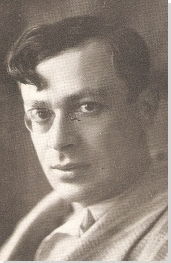Summary of Tristan Tzara
Tzara is considered the founder of Dada, a nihilistic, anti-art movement formed in Zurich during World War I. Although also producing artwork, his primary contribution was publishing manifestos outlining the goals of Dada and circulating them to as wide an audience as he could solicit and arranging vulgar and shocking performances at a local Café featuring deconstructed language and outrageous acts purposefully intended to shock his audience and upset all preconceived expectation. Tzara worked hard to spread Dada, formulating the Dadaglobe project intended to catalogue Dada output across the world and introducing his own brand of chaotic spectacle to the Parisian avant-garde in the mid-1920s. By 1930 he began to break away from the destructive side of Dada and began to explore Surrealism, a movement propagated by his friend André Breton, with its combination of juxtaposition and chance. Throughout his career he strove to overcome what he felt were the evils of bourgeois society and to offer, in their place, an antidote based on a distinct lack of historical precedent.
Accomplishments
- Tzara found and propagated Dada art in Zurich during World War I, determined to find an alternative to tradition, history, and the continuation of what he considered the pernicious bourgeoisie. From 1916 Tzara organized violent, disruptive, and unexpected performances at the Café Voltaire specifically meant to shock and upset his audience - all part of his effort to spread a kind of anti-art, one no longer based on any formerly understood societal standard. The artist continued his Dada activity in Paris in 1919, transforming literary gatherings and organizing performances intended, from the start, as a form of "hoax" or "trick" on his the public.
- Tzara's interest in African art and poetry paralleled the interests of many contemporary European artists interested in so-called Primitive art as a way of breaking from the long-held Western tradition. His incorporation of African chants and dances into his performances added elements unfamiliar to most in his European audiences and encouraged an association common, even if problematic, among the Dadaists between Primitive arts and the subconscious.
- Tzara used a particular style, which he called "cut-ups," for both his visual and literary oeuvre. In this method either a text (for a poem) or an image (for a drawing or print) was cut into pieces and then recomposed. The final work was a result of chance and juxtaposition. This technique was perfect when, influenced by Andre Breton, the artist began to explore Surrealism, allowing him to extend earlier ideas to new applications espousing an investigation of dreamlike states, ulterior realities, and the workings of the unconscious.
Important Art by Tristan Tzara
Unpretentious Proclamation
Tzara co-founded Dada in Zurich. The Manifestos he wrote from 1916, including this one regarding "unpretention," all outlined the principles of the movement as well as its raison d'etre. "Art needs an operation." - with these uncompromising words Tzara set forth his philosophy that Art with a capital A was pretentious and that traditional artists were self-absorbed hypocrites. He called for something he called "Dada's magic revolver" to put "Art" (any work of creativity) to sleep (really, put aside) so that a new world that emphasized life and the living could be born. The Dada movement initiated a militant anti-art revolution. As Tzara explained: "Get ready for the action of the geyser of our blood-submarine formation of trans chromatic aeroplanes, cellular metals numbered in the flight of images above the rules of the hand."
This Unpretentious Proclamation, released a few years into the movement, not only outlines its precepts but also indicates its visual idiom. The typeface, a corrupted version of standard Victorian print, was purposefully chosen. Tzara co-opted typefaces from advertisements and newspapers and changed the font, orientation, and boldness in an effort to articulate his ideas. This text indicates the inherent contradiction of the Dada position: making art while simultaneously denying it.
Type on paper
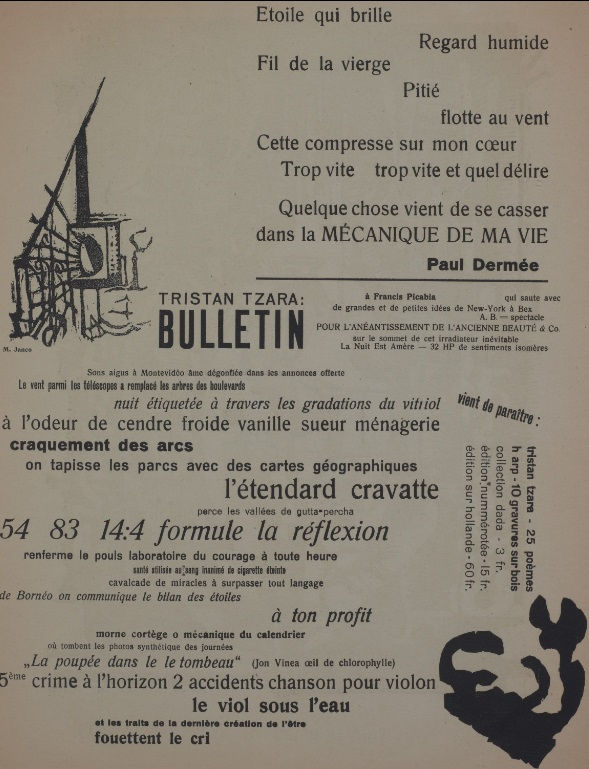
Contents, Dada 3
This bulletin illustrates Tzara's "cut-up" style wherein pieces and morsels of previously printed material were gathered and juxtaposed in what seems a random manner, coming together to form an artwork as if by accident. As he specifically recommended for poems: "Take a newspaper. Take a pair of scissors. Choose an article as long as you are planning to make your poem. Cut out the article. Then cut out each of the words that make up this article and put them in a bag. Shake it gently. Then take out the scraps one after another in the order in which they left the bag. Copy conscientiously. The poem will be like you. And here you are a writer, infinitely original and endowed with a sensibility that is charming beyond the understanding of the vulgar."
This same technique was recommended for visual material and it can be seen in this Bulletin where syntax and imagery are arranged in an unconventional manner. Tzara explained "Every page should explode, either because of its profundity, or because of its vortex, vertigo, newness, timelessness, crushing humor, enthusiasm of its principles, or the way it is printed." Here text is arranged in bits and bursts on the page, some running left to right but other surprisingly running up on an angle or tipped to the side. There's no clear margin and no formal arrangement into paragraphs, instead lines wrap around in an almost random fashion. The illustrative material is squeezed into the space that remains in an almost coincidental fashion.
Tzara's efforts in these works of typographic collage share a lot with those of other Dada artists including Janco. The concept of collecting items or bits or words and arranging them on the page so that the viewer is forced to find meaning was consonant among all the artists active in this movement.
Typographic Collage - Ink on Paper
Dadaglobe solicitation form letter
This missive, primarily instigated by Tzara, outlined the goals of the Dadaglobe project as well as clearly presenting its stylistic idiom. The Dadaglobe intended to further promote the international nature of the movement and serve as a cross-cultural guidebook to the future of art. It was an encyclopedia that included self-portraits, photomontages, collages, drawings, poems, and book designs from artists across the world including the former combatant states of Germany and France. To insure its international availability he planned to publish in French, German, and English.
Tzara worked on the project from 1920-21, collating material received from a range of artists including Hans Arp, Andre Breton, Max Ernst, Hannah Hoch, and Sophie Taeuber-Arp, before abandoning it. The letter illustrated, signed by Francis Picabia, Tristan Tzara, Georges Ribemont-Dessaignes, and Walter Serner on November 8, 1920, called on artists from all over the globe to submit writings and artworks demonstrating the global expansion of Dada. Almost one hundred years later, on the 100th anniversary of Dada's founding, the Kunsthaus Zürich brought the Dadaglobe artworks and writings together for the first time and completed Tzara's original project with the publication of Dadaglobe Reconstructed.
Printed paper
Untitled
The simplified forms and bright palette of this work reflect the artist's attraction to "primitive art," and in particular - African art. In his Dada 'Note 6 On African Art' (1917) he wrote of his fascination for this civilization, which he saw as more real, more pure: "My other brother is an innocent; he is good and laughs; he eats in Africa and in the bracelet of the Oceanic Islands." To Tzara the earliest human societies, free of social rules and conventions, were innately more authentic than the Western one from which he hailed. He found Aboriginal, African, and Maori poems in the Zurich university library and performed them, sometimes in their original language and sometimes translated, at soirées nègres at the Cabaret Voltaire. He collected African art throughout his life and would eventually be considered a specialist, at one point working as a consultant on the subject for such esteemed clients as Peggy Guggenheim. His passion for Africa never waned and in the last year of his life he travelled there to attend a Congress on African Art.
Gouache, watercolor and pencil on paper - Private Collection
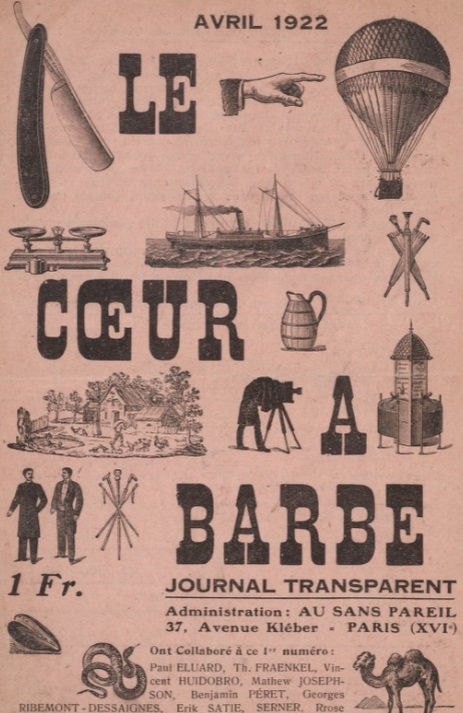
Magazine cover for Le Coeur à barbe (The Bearded Heart)
On July 6, 1923, the theatrical performance - The Bearded Heart, written and directed by Tzara, was performed at the Theatre Michel. He called it "a hoax" as it was deliberately provocative and illogical, intended to subvert a normal theatre experience. An audience coming to sit quietly and watch a play, something recognizable with a beginning, and ending and some kind of normal sense of story development, would be in for a major surprise. The performance, attended by Breton, Aragon, Soupault, Éluard, and Ribemont-Dessaignes, included nonsensical dialogue between a Mouth, Ear, Eye, Nose, Neck, and Eyebrow accompanied by bewildering ballet and music.
Tensions between Breton and Tzara had recently been raised and they had been attacking one another through the press. While Tzara claimed, "Any work of art that can be understood is the product of a journalist," Breton had countered with a press release calling Tzara an "imposter eager for fame." During the performance Breton became furious, jumping on stage waving his cane, hitting the performers, and allegedly breaking a performer's arm. The audience rioted and Tzara called the police. That night marked the split between Dada and Surrealism but relations eventually improved significantly and in 1930 Tzara directed a film titled The Bearded Heart featuring not only Louis Aragon and Paul Éluard, but Breton himself.
Black printing on pale pink stock
L'Homme approximatif (The Approximate Man)
L'homme approximatif is truly the masterpiece of Surrealism. It proves that despite the ongoing argument with Breton over the scope, direction, and relationship of Surrealism to politics and art, Tzara continued to contribute to Surrealist activities and publications. In fact, Klee's drawing (the image here) picks up on the surreal aspect of Tzara's words directly, drawing an organic shape, abstract and dreamy in nature, to stand in place of the Approximate Man described by Tzara.
The adoption of Surrealism by Tzara was not a surprise. From early on in his career he maintained hope for a future super-reality (surreality) where men would live in a state combining both waking life and the realm of dreams. The title poem of this book, L'homme approximatif, with its collection of vivid image bytes and dreamlike reality, explains how Tzara naturally segued from Dada to Surrealism.
"And on the other side for lack of sun there is death perhaps
waiting for you in the uproar of a dazzling whirlwind with a thousand explosive arms
stretched toward you man flower passing from the seller's hands to
those of the lover and the loved
passing from the hand of one event to the other passive and sad parakeet
the teeth of doors are chattering and everything is done with
impatience to make you leave quickly
man amiable merchandise eyes open but tightly sealed
cough of waterfall rhythm projected in meridians and slices
globe spotted with mud with leprosy and blood
winter mounted on its pedestal of night poor night weak and sterile
draws the drapery of cloud over the cold menagerie
and holds in its hands as if to throw a ball
luminous number your head full of poetry."
Book
Landscape
Landscape is an example of a drawing produced during a Dada game known as Exquisite Corpse. It was the product of a game involving Tzara, Valentine Hugo, Andre Breton, and Tzara's wife, the Swedish poet Greta Knutson. The game was played as follows: Player 1 drew something, folded the paper and passed it on to Player 2, who added to the painting and passed it to yet another player. The final image was, accordingly, a collaborative work created by multiple artists that was not preconceived but instead, the result of allowing the unconscious to determine and conceive as it went along; each stage, each artist's hand, was inspired by the former and acted according to the moment.
Automatism, an integral aspect of the game, generated the creative response of each artist as they received an image previously conceived by one of their friends. Although Breton pioneered its use, this technique was embraced by all, considered a perfect expression of Surrealist creation. Robert Motherwell, who became fascinated by Dada and automatism after Roberto Matta introduced him to the game in the 1940s, resurrected it and even held Exquisite Corpse evenings with other artists interested in the merits of unconscious artistic production, such as Jackson Pollock and Lee Krasner.
Colored pencil on black paper - The Museum of Modern Art, New York
Biography of Tristan Tzara
Early Period
Tristan Tzara, born Samuel Rosenstock, came from a Romanian family with Jewish roots. A highly original thinker by nature, his early years were marked by feelings of boredom with the small, agricultural town in which he lived. While attending school in Bucharest he became captivated by Symbolism, and co-founded the magazine Simbolul with Ion Vinea and Marcel Janco. In 1915 he went to Zurich, a hotbed of revolutionary ideas, to study philosophy. His freethinking, anti-bourgeois principles led to painful clashes with his family that eventually led his father to cut him off. As he later wrote, "I was dead for him."
To symbolize the formal break from his prior life, he decided to change his name. Various explanations have been offered for his choice. In Hebrew, "Ttzara'at" means one exiled from the community. In Romanian, it means "sad in the country." There are those who called him "Tzara Thoustra" in homage to Nietzsche's book Thus Spoke Zarathustra. There is no question that Tzara was intrigued by Nietzsche's nihilistic philosophy wherein God was dead. He joined many other young intellectuals who, having witnessed the horrors of the First World War, resented the nationalist and bourgeois conventions that had led to the conflict, fled to neutral Zurich for sanctuary.
Two significant, but very different, events merged from these years: Tzara's Dada movement and Lenin's political revolution. Ironically, the latter was Tzara's neighbour at the time and there is some indication that Lenin attended some Dada events as a young man. Years later Tzara told an interviewer for the British Broadcasting Corporation that although he met Lenin, and probably played chess with him in their local café, he had no idea at the time that he would go on to become the "Lenin" - the leader of the Russian Revolution.
Swiss Period
While Europe exploded into war, Tzara and Marcel Janco linked up with a group of pacifist artists and radicals, including Hugo Ball, Emmy Hennings, Richard Huelsenbeck, Hans (Jean) Arp, and Sophie Taeuber-Arp to form the Dada group. Influenced by a range of avant-garde movements, such as Cubism, Futurism, Constructivism, and Expressionism, they believed that the role of art was to upset bourgeois sensibilities and ask difficult questions about society. The word Dada means the same (or nothing) in all languages, but, showing his flair for publicity, Tzara insisted it was chosen by randomly stabbing a knife into a dictionary. Whether true or not, that story was an excellent means of advertisement of their extreme spirit.
Tzara described Dada as a "magic revolver," a peaceful weapon that would destroy all the traditions of existing bourgeois society, a "bomb," a "furious wind" with "a great negative and destructive work to accomplish." He was anti theory and pro action, intent on demystifying art. He insisted: "Art needs an operation!" In Dada 3 (1918) he wrote: "The new artist protests: he does not paint a symbolic and illusionistic reproduction, he creates directly in stone and wood, iron, clay, rock, living organisms, which can be turned in any direction by the limpid wind of momentary sensation."
Dada began when a group of artists including Tzara began to stage Dada performances at the local Cabaret Voltaire. A small café named after the 18th century French satirist whose novella, Candide, mocked the idiocies of society, this café was a perfect venue. Freethinkers keen on seeing a new type of expression, unshackled from tradition and constraint, were attracted to the electrifying anarchistic events organized there by Tzara and Hugo Ball. Tzara believed the "primitive" (non-Western) to be a more honest method of pure communication, and accordingly nothing, whether sex, death, cannibalism, masturbation or suicide, was taboo. All of these themes were re-enacted within those performances, accompanied by outrageous and unexpected actions including vomiting, painting, shouting "sound poems" (phonetic nonsense verse), African chants, drumming, and dance. As Tzara was particularly interested in African art, publishing African poems he'd discover at the library in Dada journals, the performance of "chants nègres" was a regular event at both the Cabaret Voltaire and the other location frequented, the Zunfthaus zur Waag. Tzara's performances were very physical, sometimes he shouted and pounded on the tables. When Ball became uncomfortable with Dada's direction, Tzara took the lead. He became an icon, with his charming personality and well-known eye monocle, for his pacifist, yet rebellious manifestos, the first of which was published in 1918 (there were eventually seven, the last published in 1924).
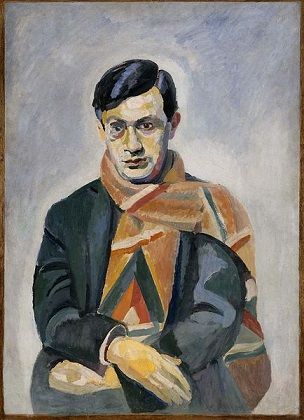
Tzara experimented and innovated in typography as well, working newspaper and advertising type into his manifestos, mixing up article clippings and words. He was quick to hail the new media of photography and film, noting: "When everything that called itself art was stricken with palsy, the photographer switched on his thousand candle-power lamp." He appreciated the artistic freedom these new media offered, embracing the photo montages of words, sounds, typography and art he'd noted in Cubist papiers colles as well as Futurist sculpture.
As well as a poet, performer, and writer of manifestos, Tsara was a master at propaganda. He made sure that Dada proclamations were aggressively circulated, both in Zurich and throughout Europe. Firmly convinced that nationalism led to war, Dada demanded "no more paintings, no more men of letters, musicians, sculptors, religions, republicans, royalists, imperialists, anarchists, socialists, Bolsheviks, politicians, proletarians, democrats, armies, police, countries, we have had enough of all these idiocies, no more anything, nothing, nothing, nothing." Tzara conceptualized Dada as a "virgin microbe" with which he would, through his multilingual journal, infect the world. He called on Dada "to shit in many colors to ornament the zoo of art with the flags of every consulate." Local and ex-pat Dada groups emerged in Paris, Cologne, Berlin, Hanover, and even as far as Russia and New York. Marcel Duchamp, Man Ray, and Francis Picabia became international spokesmen in New York; the young Breton continued its practice in Paris.
Paris Period
Tzara relocated to Paris in 1920, sparking an exciting blitz of ideas, demonstrations, exhibitions, performances, manifestos and journals among the Parisian avant-garde, including Andre Breton, Louis Aragon, Philippe Soupault, Paul Éluard, Jacques Rigaut, and Georges Ribemont-Dessaignes, known as the "Dada Spring." He wrote articles for Breton's Littérature magazine as well as staging outrageous events which shocked the local audience. Tzara described his Paris Dada activities as: "antiphilosophical, nihilist, scandalous, [and] universal." His guerrilla public relations tactics brought anarchy to the city. For example, posters would promise outrageous events such as "Dada Sex Displays" only to disappoint the audience that arrived and found a large wooden phallus balanced on balloons. Huge crowds gathered to see the world's biggest star, Charlie Chaplin, deliver a lecture on Dada, only to discover he wasn't showing up at all. The more the audience rioted, the more Tzara rejoiced. There were events specifically intended to be confusing to the public, such as those where Tzara and Breton would recite competing manifestos while Picabia drew pictures on a blackboard that he immediately erased. As Tzara explained "This painting was valid for only two hours." Responding to these outrageous events, the press described the artists as madmen and lunatics possibly in need of psychiatric help.
Tzara enjoyed great notoriety and cultivated his fame; once he even sent a false news report that he'd been shot in the thigh after he and Arp had dueled. Jon Dos Passos wrote of seeing Tzara leading a crew through the streets of Paris like the Pied Piper, conducting them in strange dance moves while chanting: "Dada, Dada, Dada." In his article for Vanity Fair (1922), Tzara noted with great satisfaction that one critic had called for him to be shot and that in Paris, "for the first time in history, people threw at us, not only eggs, salads and pennies, but beefsteaks as well. It was a very great success."
Wanting to spread Dada ideas throughout Europe, Tzara launched an art and literature review called Dada in 1917 which he followed up on with his Dadaglobe project. As the latter was intended to illustrate a truly global meeting of minds Tzara wrote to artists around the world asking for contributions for what would be an anthology of poetry, writing, and artwork. Although not completed by Tzara himself, the project was resurrected nearly a century later in a Zurich-based exhibition, and eventually published with the title: Dadaglobe Reconstructed.
Tensions between Tzara and Breton in Paris eventually caused a rupture in their relationship. Tzara believed in chaos and that there was no such thing as ultimate truth. He rejected any attempt at explanations, claiming, "Dada has no meaning." Breton, on the other hand, wanted to put ideas into a coherent system and to analyze using psychoanalytical tools drawn from Freud. Tzara maintained that analysis defused the Dada bomb and that psychoanalysis was bourgeois. Breton called Tzara a publicity-mad imposter and even alleged that he had not been the true author of the Dada Manifestos. A great argument broke out between the two in 1923 during a performance of Tzara's play The Gas Heart. The play was intended to irritate the audience with illogical dialogue, and Andre Breton, Paul Eluard and Robert Desnos were heckling loudly from the audience. At one point Breton leapt on stage, causing Tzara to call the police. This move officially ended their relationship until some time later when the two were drawn together through their mutual interest in Surrealism.
Surrealism
By 1929 Tzara and Breton had reconciled and there is no question that Breton's First Manifesto of Surrealism, promoting the unconscious, the primitive, automatism, chance, and the blurring of imagination and reality, was clearly influenced by Tzara's ideas. After publishing his Second Surrealist Manifesto, Breton noted that their earlier split "was not based on anything quite serious as we may have been led to think." Their mutual desire to create a new super reality was exhibited again and again, as with the 1931 publication of Tzara's L'Homme approximatif (Approximate Man). Begun back in 1925, this work argued that man was an incomplete "approximate man like me like you reader and like the others" and clarified his vision of the man of the future as a man truly living a surreal life. Tzara continued to write for Surrealist publications but, over time, argued more and more with Breton over both the philosophy and direction of the movement.
In 1935 Tzara participated in the Congress of The Association of Revolutionary Writers and Artists, directing a Support Committee for Spanish Intellectuals. As a delegate, he went to the Spanish front during the Spanish Civil War. Life became very difficult during the Nazi occupation of France during World War II and the artist was forced to flee Paris and go into hiding in the south of France, leaving behind his home and possessions. During this period he wrote in resistance magazines and did broadcasts for the Free French radio station. He subsequently relocated to Toulouse where he joined the intellectual group of Henri Lefebvre, a figure who had long admired Tzara's ethos of living life as art and actively applied it to Marxist efforts at social transformation.
After the war Tzara became a French citizen, repossessed his Paris home, and became very involved with the Association des Écrivains et Artistes Révolutionnaires which was linked to the French Communist party. He remained engaged in and critical of modern politics, delivering radio addresses, writing essays on Mexico and ancient Egypt and publishing a number of poems on these themes including Parler Seul (1950), The Inner Face (1953), Sign of Life (1946), and From a Man's Memory (1950). He spoke out against the Soviet invasion of Hungary in 1956 and France's relationship with its ex-colonies.
Throughout this period he continued to publish poetry but later in life turned to esoteric matters, devoting considerable time to the study and deciphering the secret anagrams he'd detected in the work of François Villon. His long manuscript on the Villon "secret code" was published after his death as Le Secret de Villon (1991).
Tzara retained a fascination for African art throughout his life, amassing a large collection of works. His expertise in the subject was acknowledged with the invitation to attend the Congress of African Art and Culture in the African Republic of Rhodesia in 1962. Back in France, he used the promotion of the Congress as a means to reassert his anti-colonialist views. He died in Paris the following year.
The Legacy of Tristan Tzara
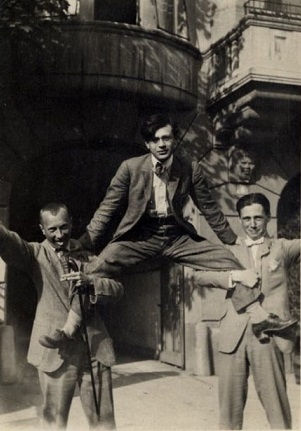
Due to the domination of Surrealism and Breton's dogmatic stance, Dada's reputation waned and by the 1940s it had disappeared completely. As the former Dada member Hans Richter noted: "Surrealism devoured and digested Dada." For a time it seemed that Breton had devoured Tzara too but in the 1950s there was a resurgence of interest in the subject. Robert Motherwell's book: Dada Painters and Poets (1951) and the 1953 Dada Exhibition organized by Duchamp acknowledge its historical contribution among the New York audience. Motherwell held Dadaist Exquisite Corpse evenings with Jackson Pollock and Lee Krasner and new artists, such as Jasper Johns and Robert Rauschenberg, were called Neo-Dadaists.
Tzara's influence in anti-art ideology and methodology can be seen in subsequent avant-garde movements which blended artistic genres (visual, literary, and musical) such as installation art, happenings, and performance art. The Dada call to destruction is evidenced specifically in Ben Vautier's Fluxus work, Total Art Matchbox (1966). There he takes Tzara's earlier exclamation that "art needs an operation, "quite literally with his exhortation to: "USE THESE MATCHES TO DESTROY ALL ART. SAVE THE LAST MATCH FOR THIS MATCH."
The use of collage in Dada, specifically Tzara's "cut up" techniques, had a profound influence on graphic design, advertising, poetry, and installation art. This technique was key to Beat Poets such as Allen Ginsberg and William Burroughs and became a popular technique for songwriters such as David Bowie. Dada's nihilistic call for destruction was influential on the 1970s Punk movement wherein a violent audience reaction became a goal and musicians scream, spit, and fight in a manner similar to what had been seen at the Café Voltaire much earlier. The Sex Pistols specifically adopted the "cut up" technique for the song titles in their typographic collage and photomontage on their Never Mind the Bollocks album. A less provocative reflection of the Dada mixed media performance ethic is evident in Neo-Dada works such as John Cage's Theatre Piece No 1 (1952) and David Bowie's costumes are usually considered the result of those seen in Tzara's play The Gas Heart.
Influences and Connections

-
![Hans Arp]() Hans Arp
Hans Arp -
![Francis Picabia]() Francis Picabia
Francis Picabia -
![Hugo Ball]() Hugo Ball
Hugo Ball -
![Hans Richter]() Hans Richter
Hans Richter ![Richard Huelsenbeck]() Richard Huelsenbeck
Richard Huelsenbeck
-
![André Breton]() André Breton
André Breton -
![Robert Motherwell]() Robert Motherwell
Robert Motherwell ![William Burroughs]() William Burroughs
William Burroughs![David Bowie]() David Bowie
David Bowie
-
![Dada]() Dada
Dada -
![Surrealism]() Surrealism
Surrealism -
![Neo-Dada]() Neo-Dada
Neo-Dada -
![Pop Art]() Pop Art
Pop Art ![Beat Generation]() Beat Generation
Beat Generation
Useful Resources on Tristan Tzara
- The Dada Painters and PoetsBy Robert Motherwell
- TaTa Dada: The Real Life and Celestial Adventures of Tristan TzaraBy Marius Hentea
- Dada & SurrealismBy Matthew Gale
- Dada: Art and Anti-artBy Hans Richter (2004)
- Tristan Tzara's 'International of the Mind': Dadaglobe (1920-21)Our PickIn Virgin Microbe: Essays on Dada, Michael White
- Seven Dada ManifestosOur PickBy Tristan Tzara
- Approximate Man and Other WritingsBy Tristan Tzara (Mary Ann Caws)
- Dadas on Art: Tzara, Arp, Duchamp and OtherOur PickEdited by Lucy Lippard
 Ask The Art Story AI
Ask The Art Story AI